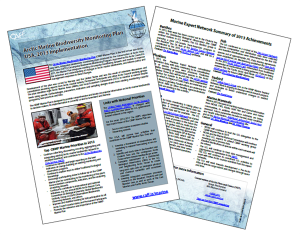Arctic Research Program releases Arctic Marine Biodiversity Monitoring Implementation Plan Annual Report
 The Arctic Research Program has released the U.S. 2013 Annual Report for its role in the Arctic Marine Biodiversity Monitoring Implementation Plan. The Arctic Research Program, which falls under CPO’s Climate Observations Division, leads this effort for the United States.
The Arctic Research Program has released the U.S. 2013 Annual Report for its role in the Arctic Marine Biodiversity Monitoring Implementation Plan. The Arctic Research Program, which falls under CPO’s Climate Observations Division, leads this effort for the United States.
The CBMP-Marine Plan is the first of four pan-Arctic long-term integrated biodiversity monitoring plans produced by the Conservation of Arctic Flora and Fauna (CAFF), a working group of the Arctic Council. Approved by the Arctic Council in 2011, the Marine Plan integrates existing circumpolar monitoring datasets and models in order to improve the detection and understanding of changes in Arctic marine biodiversity, and informs policy and management responses to these changes.
The plan identifies eight Arctic Marine Areas (AMAs) and Focal Ecosystem Components (FECs) to monitor at various trophic levels using specific methodologies, parameters, indicators and sampling designs drawn from existing monitoring capacity (programs), best practices and data. The CBMP-Marine Plan is designed to provide comprehensive and timely circumpolar information on Arctic marine biodiversity to decision makers.
The 2013 report describes the advances that the U.S. expert team has made in the areas of monitoring the Arctic benthos, plankton, sea ice biota, fish, seabird and marine mammals.
Other countries that participate in the plan are Canada, Russia, Greenland-Denmark, Iceland, Faroe Islands, and Norway.
To view the U.S. 2013 Annual Report, please download a PDF by clicking on this link: ARP Marine Report.pdf